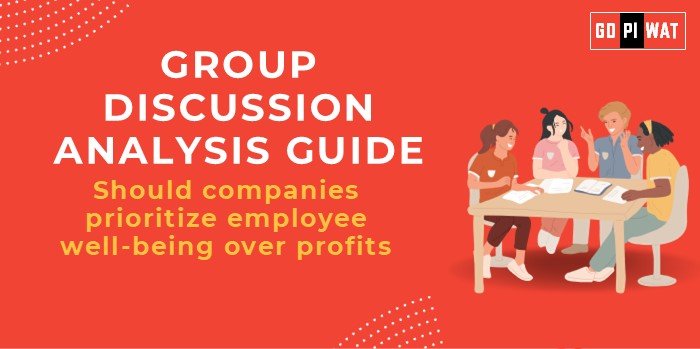📋 Group Discussion Analysis Guide
🌟 Introduction to Employee Well-being vs. Profits
In an era marked by increased burnout and mental health awareness, the debate on whether companies should prioritize employee well-being over profits has gained global relevance.
The COVID-19 pandemic accelerated conversations around work-life balance, employee health, and flexible work policies. Organizations like Google and Salesforce champion employee-centric approaches, sparking discussions about the correlation between well-being and long-term profitability.
📊 Quick Facts and Key Statistics
- Gallup Study (2023): Only 21% of employees globally feel engaged at work, highlighting the well-being crisis.
- WHO Report: Mental health issues cost the global economy $1 trillion annually in lost productivity.
- PwC Survey: Companies investing in employee well-being saw a 10-15% increase in productivity.
- Great Resignation (2021): Over 40% of employees considered leaving their jobs for better work-life balance.
🌐 Stakeholders and Their Roles
- Employees: Direct beneficiaries of improved well-being practices.
- Employers/CEOs: Decision-makers balancing profit goals with human capital investments.
- Government Bodies: Regulators ensuring compliance with labor laws and workplace safety.
- Shareholders: Often focused on short-term profits but increasingly considering ESG (Environmental, Social, Governance) metrics.
🎯 Achievements and Challenges
Achievements
- Productivity Gains: Companies like Microsoft Japan reported a 40% increase in productivity after implementing a 4-day workweek.
- Reduced Turnover: Organizations prioritizing well-being see lower attrition rates (LinkedIn’s Global Talent Trends Report).
- Improved Brand Image: Employee-centric policies enhance corporate reputation, aiding talent acquisition and customer trust.
Challenges
- Short-term Costs: Well-being initiatives like health programs or flexible schedules may strain immediate financial results.
- Measuring ROI: Quantifying the exact return on investment for employee well-being remains difficult.
- Balancing Priorities: Competitive markets may push companies to prioritize profits over culture and well-being.
Global Comparisons
- Denmark: Known for workplace happiness due to flexible work environments and strong labor laws.
- Japan: Despite cultural challenges, companies are experimenting with shorter workweeks to improve well-being.
📌 Case Studies
- Salesforce: Focused on holistic well-being, including mental health days and wellness reimbursements.
- Unilever: Integrated mental well-being programs to boost long-term productivity and employee satisfaction.
💡 Structured Arguments for Discussion
- Supporting Stance: “Employee well-being is not an expense but an investment. Studies consistently show that happier employees are more productive and loyal, driving long-term profitability.”
- Opposing Stance: “In a competitive business environment, prioritizing profits is critical for survival. Companies cannot always afford expensive well-being initiatives, especially during downturns.”
- Balanced Perspective: “Employee well-being and profits are not mutually exclusive. Sustainable profitability is achieved when companies balance employee satisfaction with financial performance.”
✅ Effective Discussion Approaches
- Opening Approaches:
- Statistic Start: “A WHO study shows $1 trillion in productivity loss annually due to mental health issues, signaling a clear need for change.”
- Case Study Lead: “Microsoft Japan’s four-day workweek increased productivity by 40%, proving that prioritizing well-being can yield financial gains.”
- Counter-Argument Handling:
- Acknowledge: “Yes, well-being initiatives have upfront costs…”
- Rebut: “But companies like Salesforce demonstrate that healthier workplaces save money through reduced attrition and absenteeism.”
🔎 Strategic Analysis of Strengths and Weaknesses
SWOT Analysis
- Strengths: Improved morale, increased productivity, enhanced brand image.
- Weaknesses: Immediate financial strain, difficulty measuring ROI.
- Opportunities: Long-term growth through employee retention and innovation.
- Threats: Short-term investor pressure, market competitiveness.
📘 Connecting with B-School Applications
- Real-World Applications:
- Leadership and HR projects focusing on well-being strategies.
- Corporate sustainability programs integrating employee-centric ESG metrics.
- Sample Interview Questions:
- “How can companies balance employee well-being with financial goals?”
- “Do you believe profitability suffers if companies prioritize work-life balance?”
- Insights for B-School Students:
- Future leaders must recognize the role of well-being in building sustainable businesses.
- Aligning human resource strategies with financial performance fosters long-term success.


